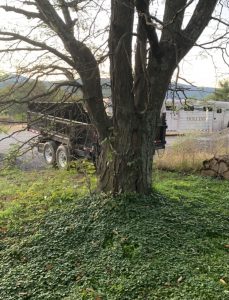
The tree that the organism was on.
October 6, 2020
Time Arrived: 6:20 pm
Time Left: 7:40 pm
The organism that I picked is a specific type of beetle known as the Rhizotrogus majalis (European chafer). This insect is a beetle from the family Scarabaediae. and was formally found only on the continent in Europe however, this invasive species was later found within the temperate latitudes in Northern America. In relation to my sit spot, the Organism was located northwest Up my typical sit spot which faces the West direction . It was behind one of the surrounding pine trees , and located on a white Oak tree , with large amount of lichens and moss. The adult beetles are medium in size, with a light reddish-brown appearance, being approximately 13 to 14 millimeters in length. They contain specific features including a narrow band of light-yellow setae that is typically found on the underside of the thorax, which is also colored in a similar setup. I chose this specific Organism because it had stood out to me since it was something I wasn’t familiar with and had never seen before at my sit spot , but looked very fascinating to follow and analyze its behavioral characteristics. It stood out amongst the dark Gray and green lichens on the tree and was surrounded by another European chaffer no more than a few inches away from it. Once looking at it from afar I had realized that there were several of these European chaffers hidden amongst the tree located near the bottom portion of the branches near the shrub like ground.
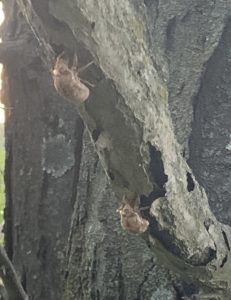
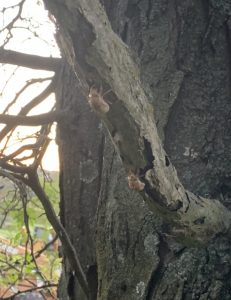
The organism on the tree-the Rhizotrogus majalis (European chafer).
While closely examining this insect, I had noticed that it did not move much, besides occasionally moving its legs and twitching as it crawled further up the tree branch. The legs and body of the insect looked almost fuzzy as if it had small fur or hair-like structures along its torso. Its legs were distinctive with hooks and looked almost sharp to attach on to the tree and create a better hold. While examining the insect up close I had noticed that it was heavily invested with grubs and had almost an arch in its back as it clung onto the tree. The insect was about one inch in length. As the European chafer had moved around, I had noticed that it was almost hairy on its underside of its thorax with textured legs. Moreover, The European Schaefer had seemed so calm and almost harmless as it had not moved much while gripping onto the tree. It almost seemed as if the specific insect was interacting with the nearby insects of the similar species. It was almost fascinating to notice the way that the almost over like torso and small brown head clung onto the tree. It had two small antennas at the top of its head perhaps used to sense things in this way. It contained longitudinal lines on its wings that seemed very eccentric. Based on where the insect was located on the tree led me to believe that it preferred cooler temperatures and had it developed near the ground as it had tended to stay near the ground as well. The European chafer had seemed to emerge near the dusk hours and clung onto the silhouette of the trees until it had gotten darker. There seemed to not have been many predators around, due to the fact that these insects were out in the open and not afraid of any other species to see them , as they were also camouflaged within the tree itself.
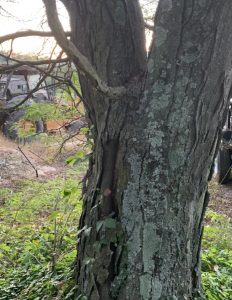
A picture further away from the tree of where the lichens were on the tree, and the organisms attached to it.
The natural history I found on the European chafer is, that it is actually a very serious grub pest of the turf that can cause large amount of turf damage; even being larger than the damage of the Japanese beetle. This difference seems to occur because the European chafer spends most of its time beating on the turf. Nonetheless, the adult European chafers do not eat at all, therefore not being the problem that correlate with the Japanese beetles. However, many home lawns, golf courses, turf growers have been potentially exposed to the significance impact of the European chafer beetle, which is slowly establishing itself throughout The United States. The European chafers spread westward into the Great Lakes region by the 1990s and had reported to be in the turf within western Ontario and Michigan. This range create the most important location for grubs attacking the home turf in combination with the mixed populations of the Japanese beetle. The European chafer seems to feed later in the fall in earlier in the spring therefore being more invasive and apparent than the Japanese beetle. The European chafer has gradually managed this way to be associated with soil-applied insecticides, including organophosphates, isofenphos, and diazinon, or even halofenozide. The neonicotinoid insecticides Seems to create an effective and various approach of the agricultural pests that have been seen too be used as seed treatments within the northern American crop field production. These adult beetles seem to emerge from the soil between mid-June in Michigan and New York, however the emergence times can very independent based on the temperature. In June and early July when the females lay up to 300 eggs in the soil , the eggs hatch in about 2 weeks with the small grubs beginning to feed on the roots of the turfgrass only. The heavy infestations can lead to the turf feeling “spongy” as the grubs seemed to tunnel through. These statements lead to the conclusion that the invasive species can become very harmful to the point of heavy infestations.
Identifying my organism was a bit difficult because I could not find specifically what the organism look like based on specific characteristics. However based on my descriptions I had written in my Journal entry I was able to narrow down by searching on the web and through identification apps, to specifically distinguish aspects of the organism. Luckily after researching for quite a bit and examining specific organisms that are native to Virginia and specific areas of the country in general, I was able to locate and specifically determine that my organism was a European chaffer. I found the entire experience of researching in trying to identify the organism to be very entertaining, As I was able to learn a lot of information about the organism itself as well as characteristics within its species. I was able to look at the pictures that I had taken of the species as well as analyze specific aspect of other similar insect and narrow down my final results. I found the researching facet to be a lot of fun but, a bit stressful because I couldn’t find specific organism for a little while. nonetheless I was determined and I found the exact species and found out a handful of fascinating knowledge.
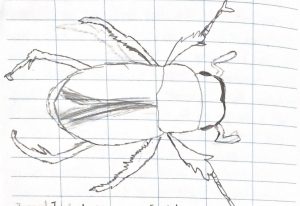
My very rough sketch of the European Chafer.
I think that the whole process of observing the Organism for 30 minutes and later researching the specific type of Organism was a very unique and intelligent approach to be more hands-on with our sit spots and to gain a stronger development in specific characteristics and being concise and thoughtful with our descriptions. I was able to also do research on my organism and learned a handful amount of fascinating analytics that I had never heard of before. I think that this was a rather enticing approach of using our sit spot time to not only connect with the nature aspect of the assignment but to also recognize the significance of organisms and species further within their environment. It was also really cool to actually search for the organism that I wanted to observe because I had found a bunch of really cool organisms and species which led me to want to research those as well.
References:
Difonzo, C. D., Smith, J. L., & Schaafsma, A. W. (2015). Effect of European Chafer Larvae (Coleoptera: Scarabaeidae) on Winter Wheat and Role of Neonicotinoid Seed Treatments in Their Management. Journal of Economic Entomology, 108(2), 566-575. http://dx.doi.org/10.1093/jee/tov002
Martínez, L.,C., Plata-Rueda, A., Zanuncio, J. C., & Serrao, J. E. (2014). COMPARATIVE TOXICITY OF SIX INSECTICIDES ON THE RHINOCEROS BEETLE (COLEOPTERA: SCARABAEIDAE). The Florida Entomologist, 97(3), 1056-1062. https://hollins.idm.oclc.org/login?url=https://www.proquest.com/docview/1586121818?accountid=27472

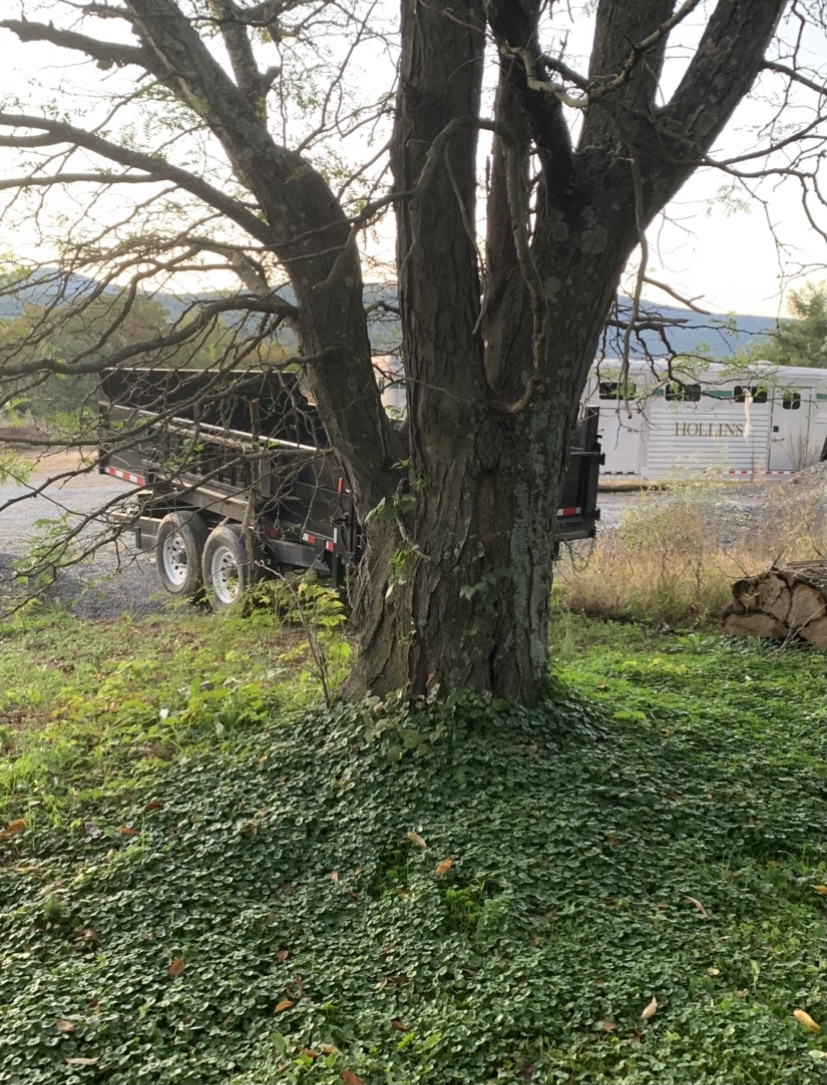
Isn’t it so crazy to learn that many of the insects we consider harmless are actually the opposite? We do not even realize most of the time; Insects like beetles can be so docile and barely seem to do much when we have the chance to observe them. Thanks for educating me on this beetle!